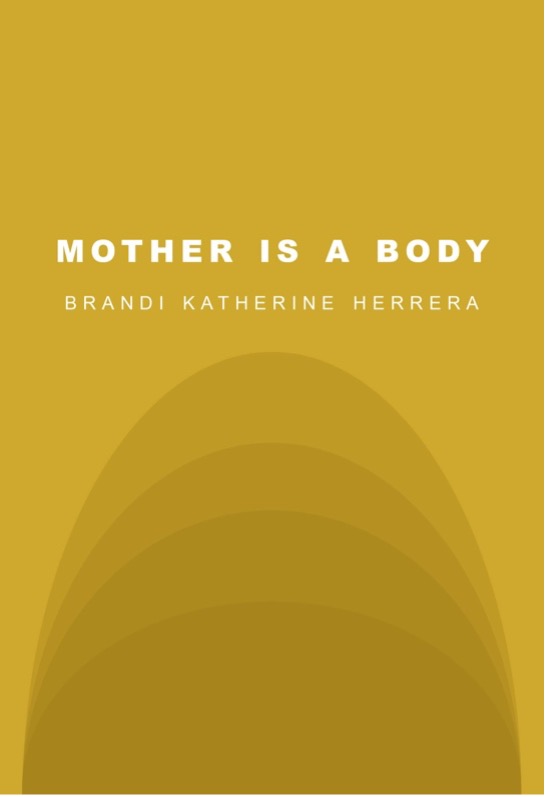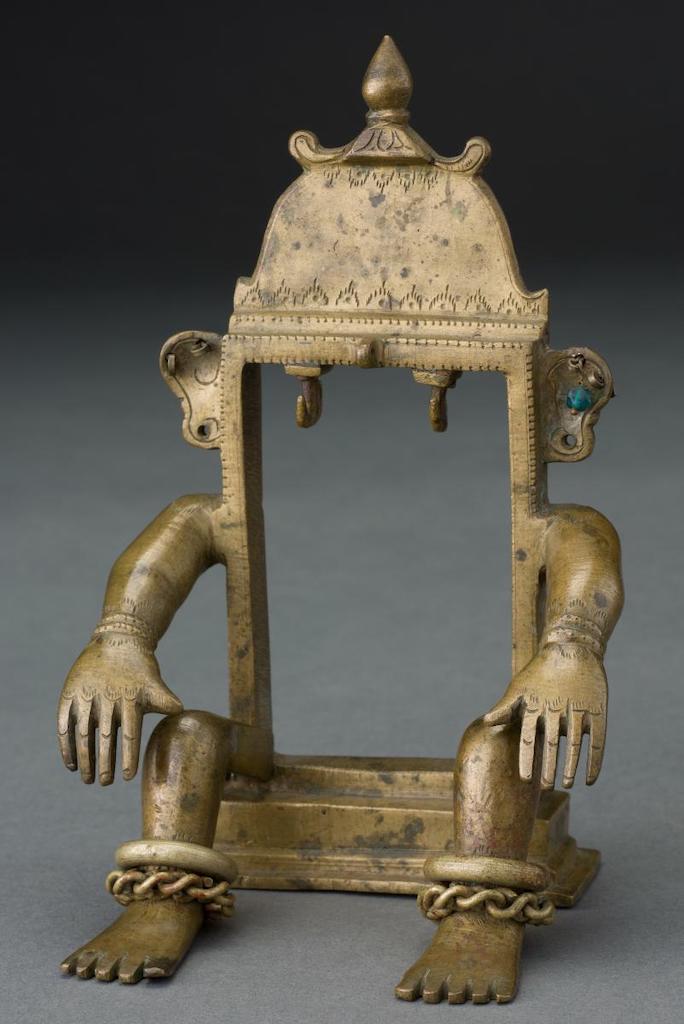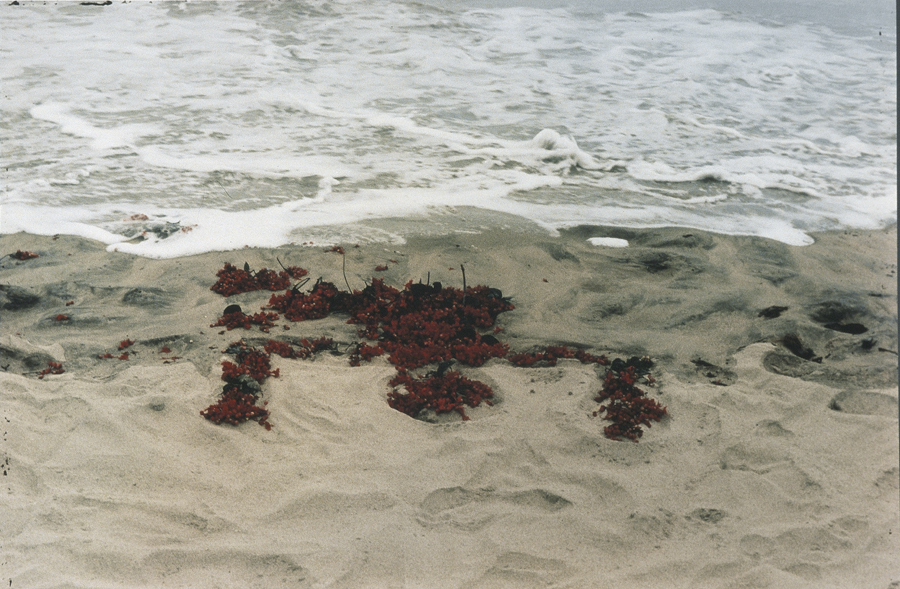
This essay was first made available last month, exclusively for our Patreon supporters. If you want to support Full Stop’s original literary criticism, please consider becoming a Patreon supporter.
The day I spoke with Brandi Katherine Herrera about her piercing, elegant, inventive book MOTHER IS A BODY, I also spoke with Cara, a woman I lived with in my first year of college, twenty-five years ago. Cara and I hadn’t spoken in probably twenty years. She found me on social media and reached out to me. We hadn’t ever really been close, so I was hesitant to say yes. I had a pretty good idea of how the conversation would go: She’d try to summarize a lifetime, I’d try to summarize a lifetime, the results would be partial and banal, we’d ask each other polite questions and make appreciative noises at appropriate times. At some point she’d talk about her children and ask whether I have children. I’d say no. She’d hesitate then ask why. Because I prefer to do so, I’d tell the truth. The truth is that I tried to conceive a child for seven grueling years and had more miscarriages in that time than I can count on both of my hands. That those years devastated my brain, body, emotions, spirit, and marriage. That, years later, the devastation is still very much forming and deforming my life. I wouldn’t say all this—I’m not interested in shocking people. I would say that I wanted to have children but wasn’t able to.
Even this G-rated version of the truth would likely discomfit her, as it does for just about everyone. Girls and young women are brought up to believe that one must be extraordinarily careful to not have a child because it’ll happen if you so much as glance at that cute guy the wrong way. Our desire is regulated, our impulses shamed. We’re also taught that a child is a choice: When one decides to have a child, it’ll happen. As many women have begun having children later in life, there’s increasing awareness that if you’re past a certain birthday, it might take some time. But still, it’ll happen. We are not led to believe that barrenness—that brutal, belittling word I carry inside me daily—is real.
For Cara’s sake, I could lie. The lie is easier for everyone—I don a stereotypical artist persona and say I didn’t want children. This is easier because it reinforces mothers’ life choices, allowing them to judge me as selfish and immature and feel content that they have a grand secret I’ll never gain access to. They usually find a way to tell me what I’m missing.
Whether I tell the truth or lie, this exchange leaves me feeling alone and small. There is no way I have yet found to avoid this sad choreography when I speak with mothers.
Cara and I did the dance. I told her the abbreviated truth. She told me the platitudes. Then Cara surprised me by adding another move to the dance, tightening the tangle. We were talking about how different we are today from the people we were twenty-five years ago. I said that I don’t even feel like the same person, and that in a very real way, I am not. I brought up the philosophical quandary of the ship of Theseus, which asks whether a ship that has had every part of its structure replaced remains the same ship. Every cell in my body has been replaced by a different cell in the last 2.5 decades. Just about every belief I held then has been altered, too. I don’t believe in a static individual essence. I’m not the same person.
She responded that she feels like she is the same person only because of her children and if she didn’t have children, she might agree with me. Her role as a mother has been the central, steady ballast in her life since she had her first child thirteen years ago. If she wasn’t a mother, she said, she wouldn’t have any sense of continuity, nothing with which to ground her identity.

Herrera’s speaker in MOTHER IS A BODY is like the ship of Theseus, an utterly changed entity that, externally, appears unchanged. Herrera and I shared our sense of infertility as an experience of being hidden and hollow. The ship has no idea anymore if it’s even still a ship, it’s been through so much, so much has changed, it can’t recognize itself anymore, it doesn’t feel the same, it feels empty and alienated and isolated and strange and estranged—but it looks like the same ship it’s always been. The ship is broken and desolate but looks just fine.
“Baby, I mean,” an extended erasure poem, is the first poem Herrera wrote for this book. It began by encountering the work of visual artist Miriam Medrez. Medrez’s exhibition, “Exposure: Remove the needle and go inside,” centers on Deleuze and Guattari’s concept of “the body without organs.” The concept is opaque enough to ward off simple explanation, but the basic idea is that a body is not reducible to the sum of its parts. Rather, a person might metaphorically shed their own innards, relinquish the taught, in order to rebuild themselves from the outside in, bringing the world into the container of their body in only the ways they see fit.
This concept provided an image for what Herrera was living through: a prolonged, hidden physical experience that resulted in the loss of her former identity. Her physical emptying, month after month, carried with it a spiritual and psychological emptying. She felt vacant and estranged from her former self but was visibly unchanged. Isolated in a silent, invisible crisis of broken identity, the repetitive process of conceiving and emptying had erased her sense of her body, leaving only the feeling of being an absence, a hole. “Baby, I mean” explores this sense of vacancy via the image of the body as egg, a central image of Gilles Deleuze’s concept. Herrera writes:
What is left without a body with or without a self.… A body cannot baby itself empty. … The egg is empty. The body is empty. A single potential body flows in and out without a baby. What is left without a body with or without a self. And by self, I mean baby.
The first draft of “Baby, I mean” was fifty pages long and used various methods of erasure to create a relentless engine of absence. In its published version, words are systematically excised from a one-stanza prose poem over the course of sixteen pages. The words move from the poem’s body to the base of the page, where one might expect a footnote. But these aren’t footnotes in any traditional sense. They are asyntactical repetitions, cadenced indexes of their own silencing, like fingerprints on a gag.
On the poem’s first page, the entire prose poem appears in its full form. On the second page, the words “body bodies body body body body body the body body body’s body’s body body body” are removed and put in the footnote position. Kids play this game, repeating a word so many times that the signifier jettisons the signified and is replaced by pure sound. Herrera’s fascination with the aural life of poetry is evident here, as is the profoundly disturbing sense of bodilessness common to the experience of infertility. Those suffering from infertility often feel like human lab rats, captive to repetitive, demeaning processes that turn a formerly trustworthy, familiar body into a strange, combative “other,” a husk of stubborn, disagreeable matter. Under these conditions, it’s almost a given that one comes to despise and fear their own body.
Sing it: “body bodies body body body body body the body body body’s body’s body body body.” To sing is to celebrate and mourn. Herrera draws equally in this poem from absence and what can be made from absence.
Silence, emptiness, and absence are foregrounded in diverse ways not just in this poem but in the entire book. Most noticeably, blank space reigns throughout. Most of the book’s pages are predominantly empty space (and luckily Fonograf makes beautiful books so the blank pages are creamy, dense, and satisfying visual and tactile experiences). Reading that encompasses silence/absence is also a common theme, as in “Baby, I mean.” In order to read full clauses in this poem, the reader is compelled to travel across the blank space of the page to the bottommost portion where redacted words are held, then back to the original clause, creating a circle dance with absence.
Another type of interruptive or partial reading is created in “A BODY IS A TERRIBLE MOTHER,” a multi-page all-caps prose poem that spreads aggressively across the page before beginning to layer lines of text over other lines, creating a tapestry of repetitive, capitalized prose that resolves into rhythmic visual noise. This is a very different type of silence/absence, one that stems from pandemonium so profuse that it resolves into nothingness. It’s like being on a flight so long that the engines’ roar becomes inaudible.
The first poem in the book, “she said / she said,” employs yet another approach to the foregrounding of silence/absence. This poem is a sound piece (https://soundcloud.com/fonograf-editions/she-said-she-said) that tracks a conversation between two women, one of whom is a mother. The backbone of the poem is a constant refrain of “shhhhhhhhhhh.” We all bring an ocean of associations to the shush. It’s a sound we’ve heard and made throughout our lives—many of us probably even heard it in utero. Herrera downloaded a baby shusher app to create the repeated sound in this poem, so the shush feels appropriately mechanical in its relentlessness. It’s a sound that is meant to offer a baby a sense of calm but created in her (and me) a sense of anxiety. The shush is a sound which is the presence of absence, the sound of silencing. To shush is a way to comfort by ousting sound. In this poem, the shush is both directive and lack.
The sad/funny poem “#MOMLIFE” offers yet another approach to absence, this time of the visual sort. The poem begins with two directives: “Post a photo with yourself. / Scroll and scroll. // Go on / scrolling until / you / disappear.” And then, as if a spell has been cast by these words (a spell has been cast by these words), the photos that are described in these poems disappear, replaced by a black line tracing the familiar dimensions of an Instagram photo, a thin palimpsest. On each facing page, a prose poem uses flat, journalistic language to describe the photo we don’t get to see (or are spared from seeing):
POST MOTHERHOOD // 624 likes // A woman with blond hair stands next to a couch in a nursery. She is wearing nude underwear, and an oatmeal-heathered tank top. The tank top is folded up just below her breasts, exposing her belly. There are wooden hearts on the wall to her right. A polka-dot stuffed elephant on a changing table to the left. The caption is about monotony. There is an Amazon Prime box just behind the arch of her back.
If I saw this photo, I wouldn’t really see it. It would provoke in me a small surge of discordant scorn and jealousy, followed quickly by shame. I’d resist and try to deny these emotions. To do so, I’d just keep scrolling, seamlessly facilitating that denial. I don’t, however, get, or want to, scroll past this poem. I stay with the poem’s image, its absent outline. I feel the woman’s lassitude. I’m with her, in all the ways both mothers and non-mothers are sidelined and hollowed by dominant culture. Roland Barthes wrote about the punctum of a photograph, the thing that punctures the viewer’s heart, often a detail that the camera didn’t necessarily intend to capture. In this unsettling, empathetic series of poems, Herrera translates punctum to poem—an impressive ekphrastic feat. The punctum above, for me: “The caption is about monotony. There is an Amazon Prime box just behind the arch of her back.” By translating the tired medium of the digital image to the less-tired medium of the poem, Herrera allows us to be punctured, to see and feel via words what the miraculous/tired digital image has lost in its perseverant reproduction.
I was astonished by Herrera’s capacity to look with humor and empathy at social media posts glorifying and flattening the lives of mothers. When I was acutely struggling with infertility, I could not look at even a real, live mother without being overcome by rage so intense that I was terrified by my own emotions. Looking at social media images would have likely resulted in a broken phone and an even-more-broken heart. Our culture’s fetishization of motherhood is so pronounced that social media posts about being infertile or childless-not-by-choice are nearly nonexistent. Herrera talked about finding exactly one Instagram post (by Lena Dunham) that spoke honestly and openly about the horrors of infertility. Infertile and childless-not-by-choice women are so scared into invisibility by our learned fear of others’ judgements that I knew the sole post Herrera was talking about—our cultural silence and invisibility is that pronounced.
Jorie Graham has spoken of silence as a force which poets seek (consciously or otherwise) with the hope that the silence might correct, reroute, or silence us. She also believes that each poet has a different type of silence that we write towards: Dickinson’s silence was time, Frost’s was a particular type of clearing in a forest, Milosz’s was history. I asked Herrera what her silence is, an impossible question to answer quickly. But Herrera wrote to me a few days after our conversation to tell me more about her silence: “So much of what I’m doing in this book is giving voice to the truth of my lived experiences that felt as if they were silenced while I was in the thick of living them. So even while I do impart so much white space, so much emptiness, so much quiet in the book, in a lot of ways it feels to me like one slow scream out into a collective space.”
Is the collective space listening? Psychotherapist Jody Day writes of feeling like “a single, childless woman in my forties with no social value or position and being expected to occupy a silent third place after men and mothers.” She describes this as a failure of all waves of feminism thus far, which have rallied (crucially) behind the rights of mothers and women who have chosen not to be mothers, but has left out altogether childless women who wanted to be but could not be mothers and women struggling but failing to become mothers. She writes, “it is still only mothers who get to fully ‘become’ women.”
This view of womanhood might seem regressive. But consider the cultural and political weight of the phrase “as a mother,” how often this phrase is used, personally and publicly, to justify or bolster a woman’s point of view. What if a woman tried to use the inverse of this phrase—“as a non-mother”—to lend credence or weight to an idea?
As a non-mother who is also a mother to “Inez / Wilhelmina / Zuzu / Earnest / Merle / Ida” (Herrera’s “Les Enfants Terribles,” her nevers), Herrera offers us her unique version of the common human experience of nurturance, grief, and love. The loss of a sense of identity is common to trauma. Herrera’s left her asking who she is as a woman, as a wholly changed entity that looks the same but isn’t, a seaworthy vessel that will never see the sea.
She says, “I’m still trying to figure out what that means for me—to be a woman, in this society. … And I don’t know yet. I don’t know what I’ll become. I’m on my way there.” We all have our nevers. We are all somehow moving past those nevers in haphazard ways. The last footnote in “Baby, I mean” reads “What is left what is left.” On the next page, the last in the poem, one word appears: a generous ghost, a lavish absence, a loud silence, a staunch compass, a sturdy ballast, whether in spirit or body: “baby.”
Daniela Naomi Molnar is an artist, poet, and writer working with the mediums of language, image, paint, pigment, and place. She is also a wilderness guide, educator, and eternal student. Her work was the subject of a recent Oregon Art Beat profile by Oregon Public Broadcasting and a front-page feature in the Los Angeles Times. Her book CHORUS won Omnidawn’s 1st/2nd book award, chosen by Kazim Ali (forthcoming October 2022). Her work has been shown nationally, is in private and public collections internationally, and has been recognized by numerous grants, fellowships, and residencies. Her writing has appeared or is forthcoming in Inner Forest Service, Fugue, Moss, Tripwire, Bomb Cyclone, Capitalism Nature Socialism, petrichor, Cirque, and Variable West. She founded the Art + Ecology program at the Pacific Northwest College of Art and is a guide and founding Board member of Signal Fire. She can be found in Portland, Oregon or at www.danielamolnar.com / @daniela_naomi_molnar.
This post may contain affiliate links.








